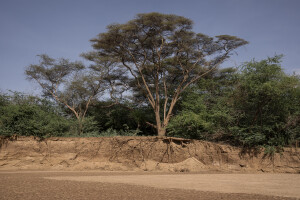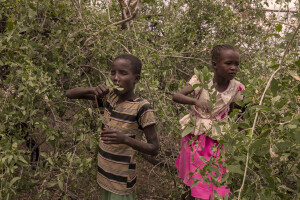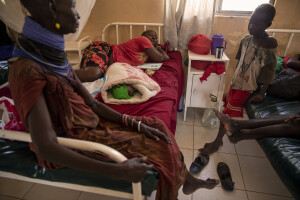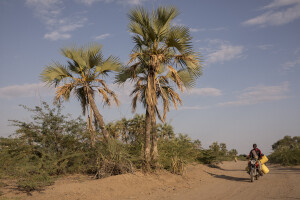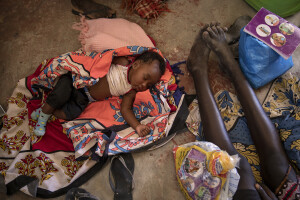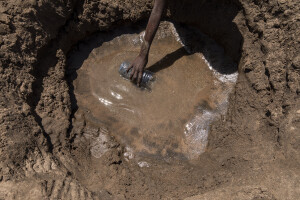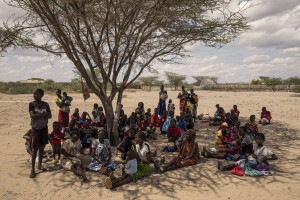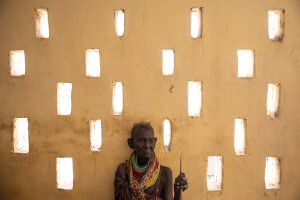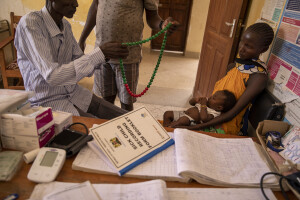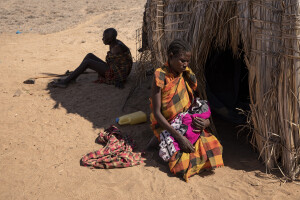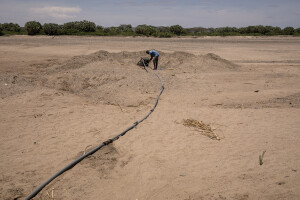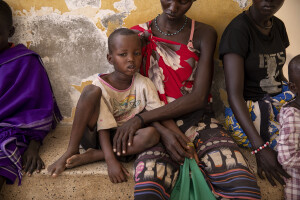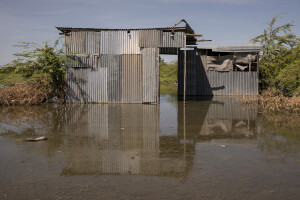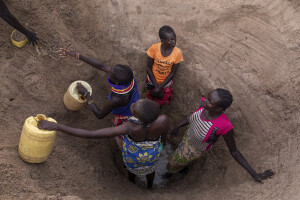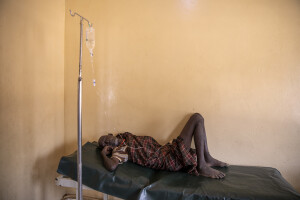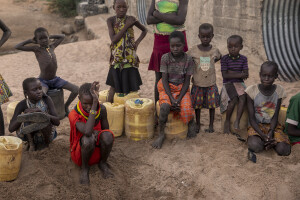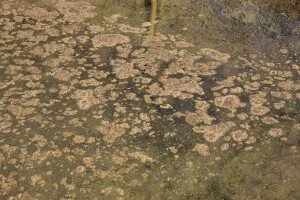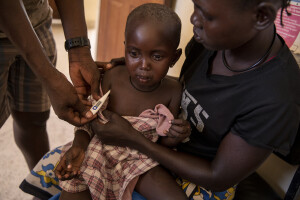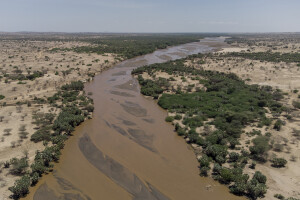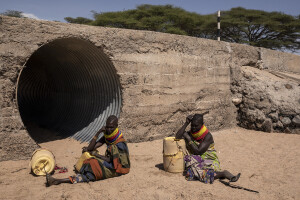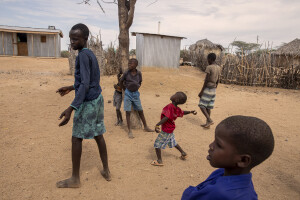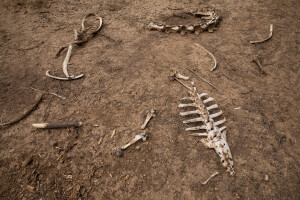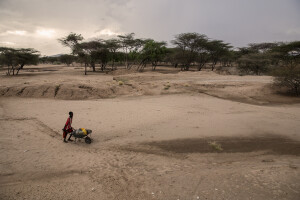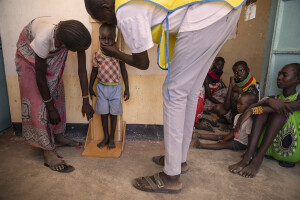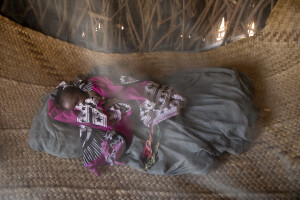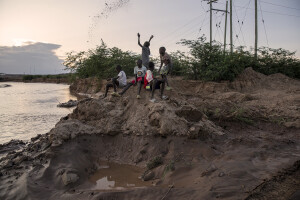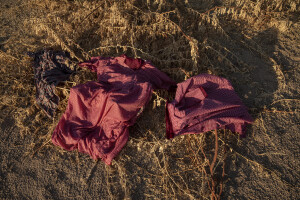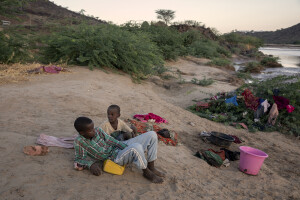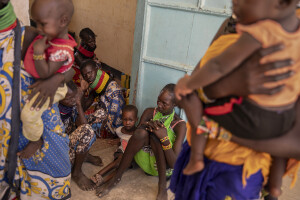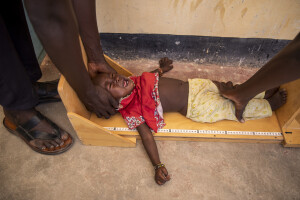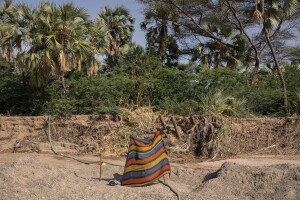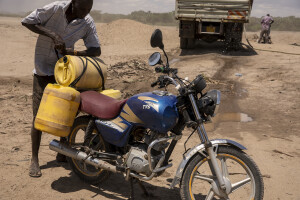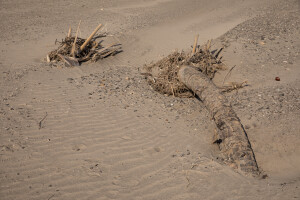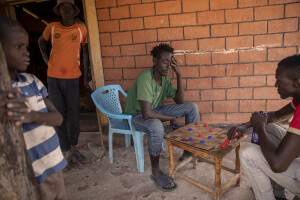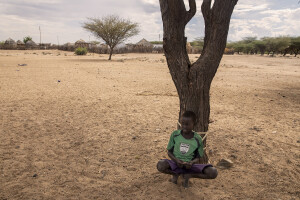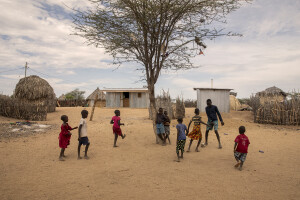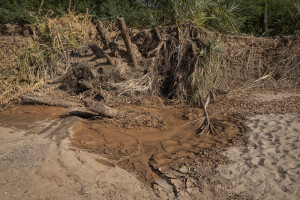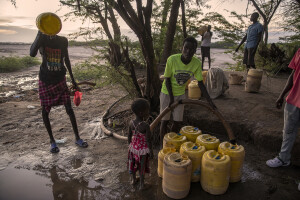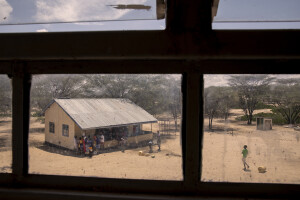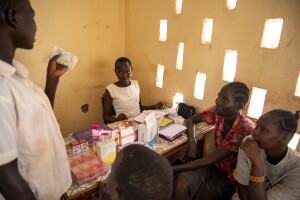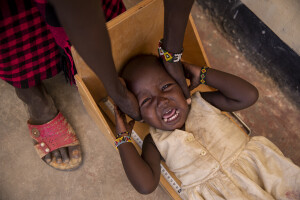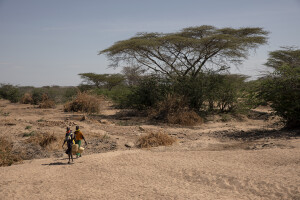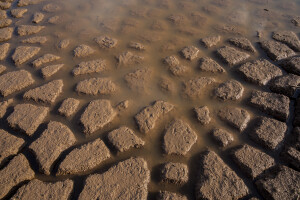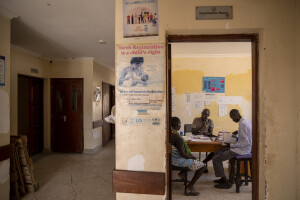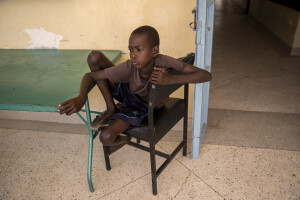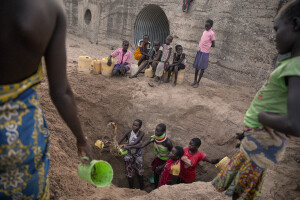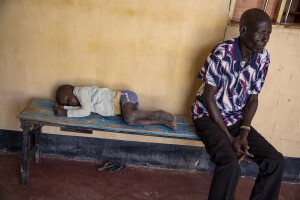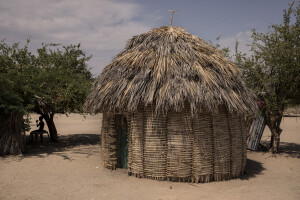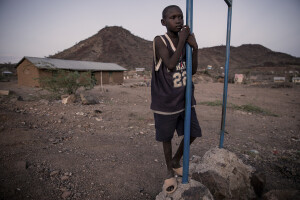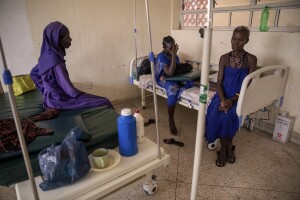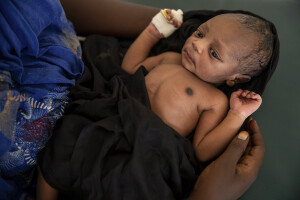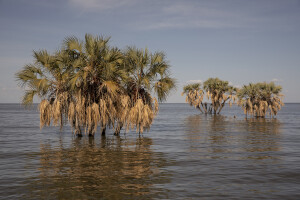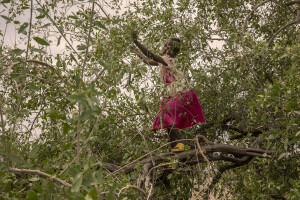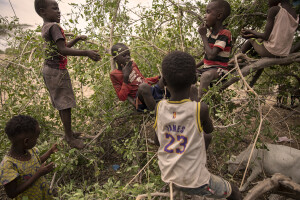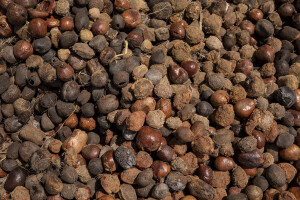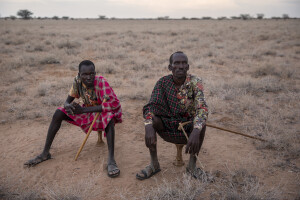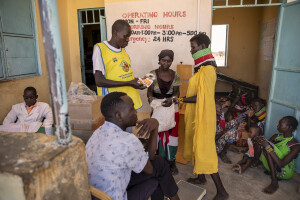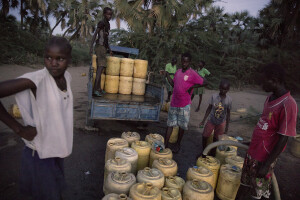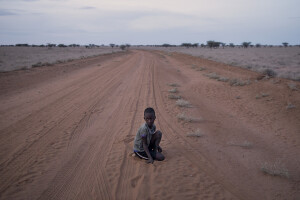Kenya is one of the countries most affected by climate change. Drought, a phenomenon that once followed predictable seasonal cycles, has become increasingly frequent and intense. According to the United Nations, what the Kenyan people are experiencing at this historical stage is the worst water crisis in the last 40 years and is leaving millions of people without stable access to safe water sources. Rivers, lakes and aquifers are slowly drying up. Water scarcity is having devastating effects especially in arid and semi-arid regions - which represent about 80% of the national territory - where women and children are forced to travel ever greater distances every day to collect water from the subsoil, which is not clean and causes infections and diseases.
The persistent absence of rain and the increase in temperatures have made the land uncultivable, rapidly exhausted food supplies, killed livestock and compromised the food security of over 4 million people.

The bank of the dried Kawalase river located in Turkana County, northwest Kenya on October 16, 2024. Kenya’s rivers are drying up rapidly, with low rainfall and global warming being among the main causes of this phenomenon.

Children eat leaves from an Esekon tree inside the Loreng’elop village, located in Turkana County, northwest Kenya on October 21, 2024. Due to the food insecurity generated by the severe drought, children living in the hot and dry areas of Kenya are forced to eat only the leaves of the trees for very long periods and for this reason they can easily contract infections or diseases.

Deborah, 27 years old (center) rests on the bed near her one day old son Bethwel and her mother Nachopu (left), while a little girl (right) watches them at Katilu sub-country hospital located in Turkana County, northwest Kenya on October 18, 2024. Due to the severe drought that is affecting the country, Deborah and her family, including her newborn son, are forced to drink water that they fetch from the underground, which is not clean and often causes infections or diseases, including dysentery, a leading cause of death among children under 5.

A man carries canisters of water fetched from the dried Napasinyang River in Kalokol, located in Turkana County, northwest Kenya on October 20, 2024. Some people have turned the severe drought that is affecting the country into a real business, selling each 20-litre water tank for 5 Kenyan shillings. However, the water that they fetch from the underground, is not clean and often causes infections or diseases.

A malnourished child sleeps on the floor of the Chok Chok dispensary, located in Turkana County, northwest Kenya on October 14, 2024. The Chok Chok dispensary was founded in 2016 by the Turkana Country Government and thanks to the “Nutrition Program” once a week it welcomes women and children from the surrounding villages to provide them with medicines, food supplements and to monitor their health conditions, which are put at risk by the severe drought that is affecting the country.

A child fetches water from the dried Turkwel River in Chok Chok village, located in Turkana County, northwest Kenya on October 14, 2024. Due to the severe drought that is affecting the country, many people are forced to drink water that they fetch from the underground, which is not clean and often causes infections or diseases, including dysentery, a leading cause of death among children under 5.

Women and children wait their turn outside the Kalokol Gok Health Centre, located in Turkana County, northwest Kenya on October 16, 2024. The Kalokol Gok Health Centr welcomes women and children from the surrounding villages to provide them with medicines, food supplements and to monitor their health conditions, which are put at risk by the severe drought that is affecting the country.

A woman waits her turn at the Kalokol Gok Health Centre, located in Turkana County, northwest Kenya on October 16, 2024. The Kalokol Gok Health Centr welcomes women and children from the surrounding villages to provide them with medicines, food supplements and to monitor their health conditions, which are put at risk by the severe drought that is affecting the country.

Doctors use a device to measure the heart rate of Quinta, 4 months old while her mother Nancy, 32 years old holds her inside the examination room of the Kangatosa Health Centre located in Turkana County, northwest Kenya on October 19, 2024. Kangatosa Health Centre welcomes women and children from the surrounding villages to provide them with medicines, food supplements and to monitor their health conditions, which are put at risk by the severe drought that is affecting the country.

Selina holds her one-week-old daughter Akaru as her father Emanikor rests near the hut where they live in Chok Chok village, located in Turkana County, northwest Kenya on October 14, 2024. Due to the severe drought that is affecting the country, Selina and her family are forced to drink water that they fetches from the nearest river – located about 15 kilometers from their village – which is not clean and often causes infections or diseases, including dysentery, a leading cause of death among children under 5.

A man fetches water with a mechanical extractor from the dried Napasinyang riverbed in Kalokol, located in Turkana County, northwest Kenya on October 15, 2024. Some people have turned the severe drought that is affecting the country into a real business, selling each 20-litre water tank for 5 Kenyan shillings. However, the water that they fetch from the underground, is not clean and often causes infections or diseases.

Kevin, 4 years old suffering from malaria is seen with his mother Elisabeth outside the Kangatosa Health Centre located in Turkana County, northwest Kenya on October 19, 2024. Children often go fetching water with their mothers in areas where stagnant pools of water form and mosquitoes that carry the malaria parasite proliferate. Over the past three years Kenya has suffered from intense drought, partly caused by global warming, which also provides favourable conditions for the development of these mosquitoes.

A shop partially submerged by the waters of Turkana Lake, northwest Kenya on October 15, 2024. The water level of Lake Turkana is rising rapidly. This complex phenomenon is linked to climate change, with rare but abundant and violent rainfall, but also to underground springs and movements of tectonic plates that influence water flows, contributing to the rise in water levels.

Women fetche water from the dried Kalotumum River in Kerio, located in Turkana County, northwest Kenya on October 17, 2024. Due to the severe drought that is affecting the country, many people are forced to drink water that they fetch from the underground, which is not clean and often causes infections or diseases. According a 2023 UN Water Development Report, groundwater levels are falling, forcing some communities to drill wells twice as deep as they were a decade ago.

Ariong, 60 years old lies on a bed after doctors diagnosed him with anemia and low blood pressure at Katilu sub-country hospital located in Turkana County, northwest Kenya on October 18, 2024. The severe drought in Kenya is generating food insecurity and difficult access to water. These two factors, in addition to high temperatures, are the main causes of low blood pressure and anemia, especially in older people.

Children sit near a well dug to fetche water from the dried Kalotumum River in Kerio, located in Turkana County, northwest Kenya on October 17, 2024. Due to the severe drought that is affecting the country, many people are forced to drink water that they fetch from the underground, which is not clean and often causes infections or diseases.

The tube of a mechanical extractor is placed inside a stagnant pool of water in the dried Napasinyang riverbed in Kalokol, located in Turkana County, northwest Kenya on October 20, 2024. Due to the severe drought that is affecting the country, many people are forced to drink water that they fetch from the underground, which is not clean and often causes infections or diseases, including dysentery, a leading cause of death among children under 5. Furthermore, global warming provides favourable conditions for the development of mosquitoes that carry the malaria parasite, especially around the stagnant pools of water.

Vivian, 3 years old suffering from malaria cries as a doctor measures her temperature and her mother Gladys holds her in her arms inside the examination room of the Kangatosa Health Centre located in Turkana County, northwest Kenya on October 19, 2024. Little girls often go fetching water with their mothers in areas where stagnant pools of water form and mosquitoes that carry the malaria parasite proliferate. Over the past three years Kenya has suffered from intense drought, partly caused by global warming, which also provides favourable conditions for the development of these mosquitoes.

A general view of the dried Turkwel River in Chok Chok village, located in Turkana County, northwest Kenya on October 14, 2024. Kenya’s rivers are drying up rapidly, with low rainfall and global warming being among the main causes of this phenomenon.

Two women rest on the dried Kalotumum riverbed, before starting to fetche water in Kerio, located in Turkana County, northwest Kenya on October 15, 2024. Due to the severe drought that is affecting the country, many people are forced to drink water that they fetch from the underground, which is not clean and often causes infections or diseases.

A child throws a stone to retrieve a ball stuck in the branches of a tree in Kapua village, located in Turkana County, northwest Kenya on October 17, 2024. Kapua is one of the villages most affected by the severe drought in Kenya, that is generating food insecurity and difficult access to water. Many people are forced to drink water that they fetch from the underground, which is not clean and often causes infections or diseases.

Animal bones are seen on the ground of Loreng’elop village, located in Turkana County, northwest Kenya on October 21, 2024. Due to the severe drought that is affecting the country, lots of animals are dying.

A child pushes a wheelbarrow inside a dried river in Lochwangamatak village, located in Turkana County, northwest Kenya on October 18, 2024. Kenya’s rivers are drying up rapidly, with low rainfall and global warming being among the main causes of this phenomenon.

Kennedy Ekalimon, manager of “Nutrition Program” measures the height of a child at the Chok Chok dispensary, located in Turkana County, northwest Kenya on October 14, 2024. The Chok Chok dispensary was founded in 2016 by the Turkana Country Government and thanks to the “Nutrition Program” once a week it welcomes women and children from the surrounding villages to provide them with medicines, food supplements and to monitor their health conditions, which are put at risk by the severe drought that is affecting the country.

Akaru, one-week-old sleeps in a hut in Chok Chok village, located in Turkana County, northwest Kenya on October 14, 2024. Due to the severe drought that is affecting the country, Akaru is forced to drink the water that her mother Selina fetches from the nearest river – located about 15 kilometers from their village – which is not clean and often causes infections or diseases, including dysentery, a leading cause of death among children under 5.

Children play with mud on the bank of the dried Kawalasee River in Lodwar, northwest Kenya on October 19, 2024. Kenya’s rivers are drying up rapidly, with low rainfall and global warming being among the main causes of this phenomenon.

School uniforms hung out to dry on the bank of the dried Kawalasee River in Lodwar, northwest Kenya on October 19, 2024. Kenya’s rivers are drying up rapidly, with low rainfall and global warming being among the main causes of this phenomenon.

Children sit on the bank of the dried Kawalasee River after washing their clothes in Lodwar, northwest Kenya on October 19, 2024. Kenya’s rivers are drying up rapidly, with low rainfall and global warming being among the main causes of this phenomenon.

Women and children wait their turn at the Chok Chok dispensary, located in Turkana County, northwest Kenya on October 14, 2024. The Chok Chok dispensary was founded in 2016 by the Turkana Country Government and thanks to the “Nutrition Program” once a week it welcomes women and children from the surrounding villages to provide them with medicines, food supplements and to monitor their health conditions, which are put at risk by the severe drought that is affecting the country.

A malnourished child cries as some doctors measure his height at the Chok Chok dispensary, located in Turkana County, northwest Kenya on October 14, 2024. The Chok Chok dispensary was founded in 2016 by the Turkana Country Government and thanks to the “Nutrition Program” once a week it welcomes women and children from the surrounding villages to provide them with medicines, food supplements and to monitor their health conditions, which are put at risk by the severe drought that is affecting the country.

A piece of colored cloth protects a mechanical water extractor from the sun in the dried Napasinyang riverbed in Kalokol, located in Turkana County, northwest Kenya on October 20, 2024. Some people have turned the severe drought that is affecting the country into a real business, selling each 20-litre water tank for 5 Kenyan shillings. However, the water that they fetch from the underground, is not clean and often causes infections or diseases.

A man attaches canisters of water fetched from the dried Turkwel River to his motorcycle in Chok Chok village, located in Turkana County, northwest Kenya on October 16, 2024. Some people have turned the severe drought that is affecting the country into a real business, selling each 20-litre water tank for 5 Kenyan shillings. However, the water that they fetch from the underground, is not clean and often causes infections or diseases.

The trunk of a tree is seen in the middle of the dried Napasinyang riverbed in Kalokol, located in Turkana County, northwest Kenya on October 20, 2024. Kenya’s rivers are drying up rapidly, with low rainfall and global warming being among the main causes of this phenomenon.

Two boys play checkers in Kapua village, located in Turkana County, northwest Kenya on October 17, 2024. Kapua is one of the villages most affected by the severe drought in Kenya, that is generating food insecurity and difficult access to water. Many people are forced to drink water that they fetch from the underground, which is not clean and often causes infections or diseases.

A child leaning against a tree in Kapua village, located in Turkana County, northwest Kenya on October 17, 2024. Kapua is one of the villages most affected by the severe drought in Kenya, that is generating food insecurity and difficult access to water. Many people are forced to drink water that they fetch from the underground, which is not clean and often causes infections or diseases.

Children play football in Kapua village, located in Turkana County, northwest Kenya on October 17, 2024. Kapua is one of the villages most affected by the severe drought in Kenya, that is generating food insecurity and difficult access to water. Many people are forced to drink water that they fetch from the underground, which is not clean and often causes infections or diseases.

The bank of the dried Napasinyang river in Kalokol, located in Turkana County, northwest Kenya on October 20, 2024. Kenya’s rivers are drying up rapidly, with low rainfall and global warming being among the main causes of this phenomenon.

A man (left) drinks water from a canister while another man (right) fills water cans using a mechanical extractor placed on the dried Napasinyang riverbed in Kalokol, located in Turkana County, northwest Kenya on October 15, 2024. Some people have turned the severe drought that is affecting the country into a real business, selling each 20-litre water tank for 5 Kenyan shillings. However, the water that they fetch from the underground, is not clean and often causes infections or diseases.

People are seen near a fountain outside the Kangatosa Health Centre located in Turkana County, northwest Kenya on October 19, 2024. Kangatosa Health Centre welcomes women and children from the surrounding villages to provide them with medicines, food supplements and to monitor their health conditions, which are put at risk by the severe drought that is affecting the country.

Women receiving medicine from a doctor at the Kalokol Gok Health Centre, located in Turkana County, northwest Kenya on October 16, 2024. The Kalokol Gok Health Centr welcomes women and children from the surrounding villages to provide them with medicines, food supplements and to monitor their health conditions, which are put at risk by the severe drought that is affecting the country.

A malnourished little girl cries as a doctor measures her height at the Chok Chok dispensary, located in Turkana County, northwest Kenya on October 14, 2024. The Chok Chok dispensary was founded in 2016 by the Turkana Country Government and thanks to the “Nutrition Program” once a week it welcomes women and children from the surrounding villages to provide them with medicines, food supplements and to monitor their health conditions, which are put at risk by the severe drought that is affecting the country.

Two women walk near the dried Kalotumum riverbed, before starting to fetche water in Kerio, located in Turkana County, northwest Kenya on October 15, 2024. Due to the severe drought that is affecting the country, many people are forced to drink water that they fetch from the underground, which is not clean and often causes infections or diseases.

Semi-arid earth in a section of the dried Kawalase river located in Turkana County, northwest Kenya on October 21, 2024. Kenya’s rivers are drying up rapidly, with low rainfall and global warming being among the main causes of this phenomenon.

A pregnant woman (left) speaks with a doctor (center) and a community health promoter (right) inside the examination room of the Kangatosa Health Centre located in Turkana County, northwest Kenya on October 19, 2024. Kangatosa Health Centre welcomes women and children from the surrounding villages to provide them with medicines, food supplements and to monitor their health conditions, which are put at risk by the severe drought that is affecting the country.

A child is seen inside the Kangatosa Health Centre located in Turkana County, northwest Kenya on October 19, 2024. Kangatosa Health Centre welcomes women and children from the surrounding villages to provide them with medicines, food supplements and to monitor their health conditions, which are put at risk by the severe drought that is affecting the country.

Women fetche water from the dried Kalotumum River in Kerio, located in Turkana County, northwest Kenya on October 17, 2024. Due to the severe drought that is affecting the country, many people are forced to drink water that they fetch from the underground, which is not clean and often causes infections or diseases. According a 2023 UN Water Development Report, groundwater levels are falling, forcing some communities to drill wells twice as deep as they were a decade ago.

A child probably suffering from malaria sleeps on a bench, while a man waits his turn inside the Kalokol Gok Health Centre, located in Turkana County, northwest Kenya on October 16, 2024. Children often go fetching water with their mothers in areas where stagnant pools of water form and mosquitoes that carry the malaria parasite proliferate. Over the past three years Kenya has suffered from intense drought, partly caused by global warming, which also provides favourable conditions for the development of these mosquitoes.

A little girl drinks water near the tent where she lives in Loropio village, near Turkana Lake, northwest Kenya on October 20, 2024. The water level of Lake Turkana is rising rapidly. This complex phenomenon is linked to climate change, with rare but abundant and violent rainfall, but also to underground springs and movements of tectonic plates that influence water flows, contributing to the rise in water levels.

A child stands near the bank of the dried Kawalasee River in Lodwar, northwest Kenya on October 19, 2024. Kenya’s rivers are drying up rapidly, with low rainfall and global warming being among the main causes of this phenomenon.

Anki, 27 years old (center) is seen desperate with her one-day-old son Dilan, while her mother Rebecca, 44 years old (right) and her nun friend Veronica, 50 years old (left) stand by her at Kangatosa Health Centre located in Turkana County, northwest Kenya on October 19, 2024. Due to the severe drought that is affecting the country, Anki and her family, including her newborn son, are forced to drink water that they fetch from the underground, which is not clean and often causes infections or diseases, including dysentery, a leading cause of death among children under 5.

Anki, 27 years old (center) takes care of her one-day-old son Dilan at Kangatosa Health Centre located in Turkana County, northwest Kenya on October 19, 2024. Due to the severe drought that is affecting the country, Anki and her family, including her newborn son, are forced to drink water that they fetch from the underground, which is not clean and often causes infections or diseases, including dysentery, a leading cause of death among children under 5.

Doum palm trees submerged by the waters of Turkana Lake, northwest Kenya on October 15, 2024. The water level of Lake Turkana is rising rapidly. This complex phenomenon is linked to climate change, with rare but abundant and violent rainfall, but also to underground springs and movements of tectonic plates that influence water flows, contributing to the rise in water levels.

A girl looks for leaves from an Esekon tree inside the Loreng’elop village, located in Turkana County, northwest Kenya on October 21, 2024. Due to the food insecurity generated by the severe drought, children living in the hot and dry areas of Kenya are forced to eat only the leaves of the trees for very long periods and for this reason they can easily contract infections or diseases.

Children eat leaves from an Esekon tree inside the Loreng’elop village, located in Turkana County, northwest Kenya on October 21, 2024. Due to the food insecurity generated by the severe drought, children living in the hot and dry areas of Kenya are forced to eat only the leaves of the trees for very long periods and for this reason they can easily contract infections or diseases.

Doum palm fruits are seen on the ground in Loropio village, near Turkana Lake, northwest Kenya on October 20, 2024. Due to the food insecurity generated by the severe drought, people living in the hot and dry areas of Kenya are forced to eat only the fruits of doum palm trees for very long periods.

Natagor (left) and his brother Nataluc (right) sit on their ekicholong, a traditional stool that is specifically owned by turkana men in the Katapokori village, northwest Kenya on October 16, 2024. Due to the severe drought that is affecting the country, lots of the animals that Natagor and Nataluc owned have died.

A woman (right) gets ready to use therapeutic food from Kennedy Ekalimon, manager of “Nutrition Program” (left) at the Chok Chok dispensary, located in Turkana County, northwest Kenya on October 14, 2024. The Chok Chok dispensary was founded in 2016 by the Turkana Country Government and thanks to the “Nutrition Program” once a week it welcomes women and children from the surrounding villages to provide them with medicines, food supplements and to monitor their health conditions, which are put at risk by the severe drought that is affecting the country.

A man fills water cans using a mechanical extractor placed on the dried Napasinyang riverbed in Kalokol, located in Turkana County, northwest Kenya on October 15, 2024. Some people have turned the severe drought that is affecting the country into a real business, selling each 20-litre water tank for 5 Kenyan shillings. However, the water that they fetch from the underground, is not clean and often causes infections or diseases.

A child sits on the street in the Katapokori village, northwest Kenya on October 16, 2024. Katapokori is one of the villages most affected by the severe drought in Kenya, that is generating food insecurity and difficult access to water. Many people are forced to drink water that they fetch from the underground, which is not clean and often causes infections or diseases.
